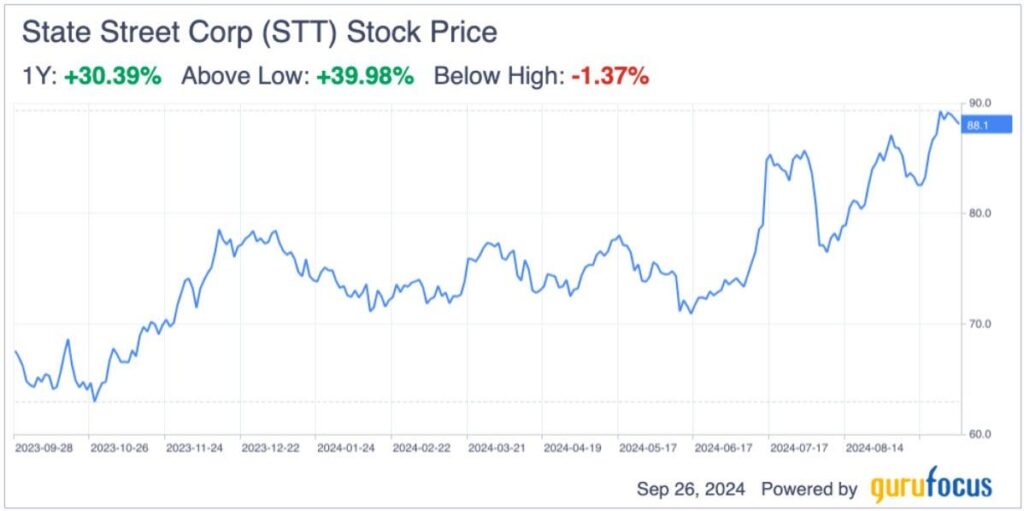State Street Corporation (STT) has seen a notable increase in its stock performance, achieving a total return of around 33% over the past year. Despite this growth, the company’s shares still trade at a relatively low valuation of 10.8 times the consensus earnings per share (EPS) for the fiscal year 2024. In comparison, the S&P 500 index trades at approximately 23 times forward earnings, while the overall financial sector is valued at about 17 times forward earnings. The combination of a low price-to-earnings ratio and a dividend yield of 3.4% makes State Street appear attractive. However, it’s essential to assess why the stock remains cheap—market conditions could indicate either a genuine opportunity or a potential value trap. Nonetheless, State Street’s business foundation, backed by strong competitive advantages and sustainable growth prospects, suggests that it is more likely a compelling investment.
State Street stands out as a pillar in the global financial services industry, primarily engaging in investment servicing and investment management. The investment servicing segment is particularly significant, contributing approximately 85% of the company’s total revenue. Its custodial services include a wide array of functions such as accounting, regulatory reporting, foreign exchange brokerage, and more, alongside managing $44.3 trillion in assets under custody. In the investment management sphere, State Street boasts around $4.4 trillion in assets under management, primarily focusing on passive investment vehicles, including Exchange-Traded Funds (ETFs). This strong market presence establishes State Street as one of the largest custodian banks in the world, giving it a distinct advantage in securing client loyalty and trust.
State Street’s market position is further cemented by the extensive barriers to entry present in the investment services sector. While the market is competitive, the need for substantial investments in technology and systems creates challenges for new entrants. The company’s significant spending—approximately $454 million on technology during a single quarter—demonstrates its commitment to maintaining service quality and operational efficiency. Clients are naturally inclined to favor larger custodial banks due to their perceived stability and reliability. This preference, compounded by switching costs and technological integration, leads to a high client retention rate of around 97% for State Street, ensuring ongoing revenue streams and promoting steady profit margins despite operating within a volatile financial landscape.
The company’s growth trajectory is entwined with market performance, as its revenue stems largely from asset price increases. State Street’s fee structures, which are calculated as a percentage of assets, mean that rising asset values directly influence revenue. However, there are inherent challenges; typically, clients negotiate fee reductions as their asset values climb, leading to a cycle of price pressure that has persisted historically. Nonetheless, the long-term growth trend remains positive, evidenced by a 5.2% annual increase in earnings per share over the past decade, largely buoyed by rising asset prices and an ongoing share repurchase program. With $4.7 billion still available for stock buybacks, which represents about 18% of State Street’s market capitalization, additional earnings growth is anticipated in the coming years.
When evaluating State Street’s valuation metrics, the current trading price of 9.8 times the consensus earnings for fiscal year 2025 stands out, particularly when compared to the S&P 500’s 23-fold valuation. Although historically, State Street’s valuations have been lower due to its limited growth prospects relative to the broader market, peers like BNY Melon and Northern Trust command higher valuations at 11.5 and 12.7 times forward earnings, respectively, despite comparable expected earnings growth trends. Furthermore, State Street’s current price-to-tangible book ratio of 1.98 also indicates a discount relative to its historical median of 2.13, reinforcing the notion of a compelling investment opportunity. Coupled with its dividend yield, which significantly exceeds that of the S&P 500, this valuation scenario positions State Street attractively for both growth and income-seeking investors.
However, the investment landscape is not devoid of risk, particularly concerning the potential for an economic slowdown. While State Street’s business model exhibits resilience during recessions, a downturn that leads to falling asset prices could adversely affect revenue and net income. Additionally, the company’s net interest income—approximately $700 million quarterly—faces threats from decreases in prevailing interest rates, often resulting from significant economic pullbacks. Hence, while the long-term outlook for State Street is optimistic based on its competitive forte and growth drivers, external economic pressures pose credible risks that cannot be overlooked.
In conclusion, State Street Corporation occupies a fundamental position within the financial services sector and while its industry operates within a mature framework constrained by limited growth opportunities, it boasts a strong competitive moat. The company’s consistent earnings growth, bolstered by substantial share buybacks and rising asset prices, offsets some of the growth limitations typical of its mature industry. Despite lower historical valuations relative to peers, State Street’s robust client retention and high barriers to entry signal a solid investment opportunity. Considering its appealing dividend yield and strategic positioning, State Street emerges as an attractive value play within the investment landscape, poised for appreciation regardless of inherent economic uncertainties. This combination of factors leads to the conclusion that State Street presents a sound investment opportunity for value-oriented investors looking for sustainable growth and reasonable returns amidst market fluctuations.

